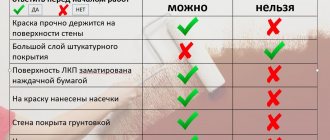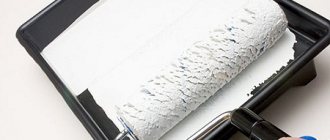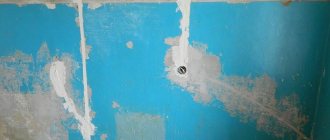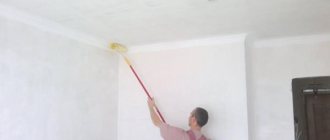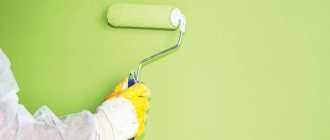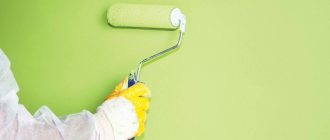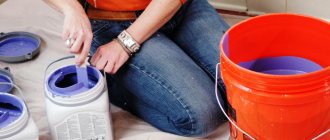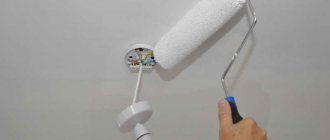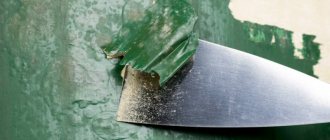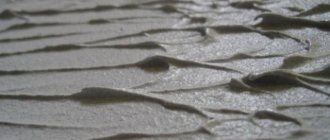Separate rooms of numerous apartments from the housing stock that we inherited from Soviet times, the walls of which, as a rule, are painted in abundance, and more than one layer - a specific sight in itself. A modern person in most cases does not like this idea of design thought, and the question arises of how to get rid of the colorful heritage of rooms in the bathroom, toilet, kitchen and corridors. Considering the fact that the surfaces, to put it mildly, are not smooth and the differences reach several centimeters, the master is not given many options.
Wash off, scrape off, remove from the wall, chemically remove the unpleasant layers of stalactites and stalagmites, get to the concrete, and then begin painting work.
Applying plaster to paint, using a specialized primer first.
Applying putty to a wall with oil paint
The first option at least has a chance of existence. Still, it is too labor-intensive and time-consuming, because removing all the paint is a very difficult task. And breathing solvents and cleaning materials is not the healthiest thing to do. Fortunately, progress does not stand still, and today a primer based on unique components, called “Betonokontakt,” has appeared in construction markets and stores.
How long does it take for primer to dry over old paint?
Retail outlets offer a special “primer for old paint.” This paint is applied to the surface with a roller in one layer. Drying time is two hours. But manufacturers recommend carrying out further work no earlier than 24 hours after painting.
Interesting materials:
The rubber on my sneakers has turned yellow, how can I whiten it? Tulle has turned yellow, how can I bleach it? The rubber has turned yellow, how can I bleach it? Curtains have turned yellow, how can I bleach them? The tulle has turned gray, how can I bleach it? The tulle has turned yellow from the sun, how can I bleach it? The tulle has turned gray, how can I bleach it? Tulle has faded in the sun, how can I bleach it? A white item is stained, how can I bleach it? How to bleach a yellow bath?
What is concrete contact
Primers based on concrete contact appeared on the Russian market relatively recently. However, she quickly gained popularity. The material is used for reliable fixation of various building materials. It provides better adhesion to tiles, porcelain stoneware and drywall, and can also be used for working with wood, metal and glass.
Companies that produce concrete contacts keep product recipes strictly secret. However, the basic performance properties remain identical for different brands.
The material contains polymer additives and fillers in the form of quartz sand, talc and other components. Externally, the material has a pinkish tint and is convenient to apply to surfaces. The characteristics of a material are determined by its composition and proportions of components. Some solutions are designed for indoor use, while others are designed for outdoor use.
However, universal designs suitable for different conditions are also available for sale. Due to its ability to improve adhesive properties, the material is in particular demand.
Wall processing conditions
To make it more convenient to apply concrete contact to walls, you should adhere to a number of conditions and rules:
- Repair activities are carried out only at positive temperatures.
- If there is high humidity outside or indoors, the performance properties of the BC will be greatly deteriorated. To avoid negative consequences, you should not start work at air humidity above 70%.
- The drying time for the primer is at least 12 hours. Only after this period has expired can you move on to the next stage.
- The structure being processed should be carefully prepared. It is cleaned of dust and dirt using detergents. Any irregularities and defects are smoothed out.
Manufacturers of concrete contact.
In the modern construction market you can find a large number. Its cost, as a rule, varies from $10 per jar (6 kg.), but can be more expensive. You can find concrete contact primer in almost any hardware store. The most popular is the product of the companies Knauf, Starateli, Ceresit.
Concrete-contact Prospectors
Concrete-contact primer is supplied in buckets of 3, 6, 20, 50 kg. It can be applied with a roller or brush. After use, all smooth, non-absorbent materials will become suitable for applying plaster to them.
Manufacturers use approximately the same formula when preparing contact concrete, so the properties of the resulting material are approximately the same. Moisture resistance, gas permeability, wear resistance. The primer also has antiseptic properties and fire safety.
In my work I use Ceresit CT 19 primer, not because it is better than others, but because at the time of purchase it was the only one in stock and it fully met my expectations. After application, you get an even and rough pink layer.
There are also many other primers on sale with similar properties, so there really is a choice.
Characteristics
Concrete contact consists of:
- sand;
- cement;
- acrylate dispersion;
- special fillers and additives.
Main characteristics of concrete contact:
- used on non-absorbent surfaces as an adhesive bridge;
- designed to strengthen the surface;
- consists of safe substances;
- does not have an unpleasant, pungent or chemical odor;
- forms a waterproof film;
- prevents the development of mold and fungi;
- for control during application, a dye has been added to the concrete contact;
- sold in solution or ready-to-use form;
- dries from 1 to 4 hours;
- The diluted concrete contact composition does not lose its properties throughout the year.
Suitable for application on the following surfaces:
- brick;
- concrete;
- drywall;
- tile;
- gypsum;
- wooden walls;
- metal surfaces
Some experts note that the composition does not adhere well to bitumen mastic, so it is better not to use the solution with it.
Application technology
Applying liquid concrete contact on a plane requires mandatory adherence to the work steps.
The workplace must be completely cleaned of dust, debris, greasy stains, traces of glue, paint, and bitumen.
Poorly adhering plaster is removed, as is wallpaper.
It is possible to remove dust as much as possible by washing the wall or floor surface; ceilings are also often washed. The main thing is to let them dry completely.
Often the purchased product is ready for use, sometimes you need to make it more liquid. For kneading, use a special attachment on an electric drill or a construction mixer.
While mixing, it is important to ensure that there are no lumps left and that the entire mixture becomes homogeneous.
When applied by brush or roller, it is usually not necessary to further dilute the composition.
Concrete contact floor covering
Wall treatment
Ceiling preparation
It can be applied with a spray gun if the surface suggests this possibility. Uneven surfaces are treated with paint brushes, which helps the solution penetrate deeper into the structure of the material. At the same time, cracks and seams are better filled.
It is better and faster to cover smooth areas with a roller. The distribution is carried out with an overlap so that there are no undeveloped areas or stripes.
If after applying the first layer there are unpainted parts left, after it has dried, apply a second layer to cover them.
The room is left for a period of 3 to 12 hours until the mixture is completely dry, then interior decoration is continued.
The manufacturer always indicates the drying time on the packaging. This figure is indicative. Drying time varies depending on placement conditions. Inside a warm room with normal air humidity, concrete contact dries faster. In damp areas, it will take longer.
Purchasing a polymer product for wall treatment is a procedure that requires significant justification. The price of the composition is high, the scope of application is narrow, you should not take the material indiscriminately. If you doubt whether such a product is needed or if you want to cover the walls with concrete contact, it is better to invite a cladding specialist for a consultation.
The process of using concrete contact is explained in more detail in the video:
What is it used for?
Concrete contact is a type of primer on a sand-cement base with a large number of polymer additives. The main task of this material is to increase adhesion (adhesion of surfaces to each other). In a few minutes you can increase the adhesion of any material to the wall. To do this, you just need to apply concrete contact.
It is very difficult to apply plaster on a completely flat wall - it will peel off and then fall to the floor. After treatment with concrete contact, the wall becomes slightly rough. Any finish will fit easily onto such a base.
When can further work be carried out?
The solution dries quite quickly - about 5 hours, some brands even faster - from 3 hours. But experienced craftsmen allow more time for drying, applying the solution in the evening and leaving it overnight.
Concrete contact is a unique primer coating with a “narrow specialization”. The cost is higher than for other types of primers, so before purchasing you should carefully read the information on the packaging and consult with more experienced professionals about the application in a particular case. Such caution will allow you not to spend too much and save on other repair needs.
Deep penetration option
In addition to the basic qualities that are inherent in all types of primers, it has the property of penetrating deeply into the top layer of the surface, slightly leveling (more precisely, smoothing) and fastening the base.
Smoothing manifests itself in the fact that the primer “glues” together small particles on the wall, dust, and sand on its surface. Unlike universal ones, deep penetration primers penetrate into the surface layer of the wall up to 5-10 centimeters.
The depth of penetration of solution particles into the base material depends on the size of these particles. A deep penetration primer glues the top layer well, binds its small particles, and eliminates looseness of the material. This leads to the fact that in addition to creating a good connection of the new layer with the base, the consumption of the applied material is also reduced.
The deep penetration primer can be used for walls under wallpaper and plaster. It is used to treat the surface of floors and walls before laying tiles. It is also suitable for use as a primer for plastered walls.
Purpose and features
Concrete contact is an acrylic adhesion additive based on quartz particles, which can be used to create rough surfaces. An important property of the composition is increased moisture permeability.
Depending on the scope of application of the BC there are:
- Under putty.
- For plastering.
The list of concrete contact features is as follows:
- The material is suitable for processing vertical and horizontal structures and promotes improved adhesion of building materials.
- BC is water resistant because it creates a special film on surfaces. Due to this property, it is used as a waterproofing agent when installing floor coverings.
- The drying time of the additive varies from 4 to 6 hours and is determined by the ambient temperature and humidity. If the humidity is high, you will have to wait at least a day before starting the next stage. A similar requirement should be followed when carrying out external work.
- Long service life. Experts say that if the application rules are followed, BC will be able to maintain its performance characteristics for 80 years.
- Working with factory compounds is quite simple. To apply them, you can use a roller, brush or other construction equipment. Due to its workability, the primer is suitable for both experienced builders and beginners.
The concrete contact contains the following components:
- Acrylic dispersion
. Provides a key adhesion additive.
- Quartz sand
. Designed to create rough surfaces.
- Cement composition
.
- Chemical modifiers
, which contribute to obtaining properties such as hygroscopicity, resistance to environmental influences and strength. Due to the absence of harmful additives, BC is an environmentally friendly material.
Concrete contact is rich in bactericidal elements that fight mold, fungal microorganisms and insects on treated surfaces. The material is characterized by neutral acidity, so it eliminates the possibility of a negative reaction with lime solutions or corrosive processes. Coloring pigments can also be added to the composition for more convenient application.
When figuring out how to apply concrete contact under tiles or gypsum plaster, you should carefully study all its properties and shelf life. They must be indicated on the packaging or in official documentation.
How to apply on walls
To obtain the best result when applying a primer, carefully prepare the surface:
- It must be cleaned of dust and dirt. Unnecessary pieces of plaster are removed using a metal brush.
- The joints between reinforced concrete panels or plasterboard slabs are coated with a primer. This will protect the plaster from crumbling.
- If the surface is clean and smooth, it must be treated with a soda solution or a special synthetic-based detergent composition. This approach will remove the fatty film.
- BC is available in liquid form, but before application it is thoroughly mixed with a construction mixer to get rid of large impurities of sand and cement.
Even before priming, you need to turn off the electrical network, since if the wiring gets wet, a short circuit may occur. The composition can be applied using different devices.
Among them:
- Brushes.
- Roller.
- Brushes.
A special spray gun is used to treat hard-to-reach areas.
The consistency of BC is similar to paint with a water-based composition, so it is quite easy and comfortable to apply. When carrying out repair work, you should regularly stir the product to prevent the thick fraction from settling.
The priming process is particularly simple, but has a number of nuances.
To avoid unpleasant consequences, you must take into account the advice of experts:
- When choosing a tool for applying primer, use a wide brush - a brush. It reduces unnecessary consumption of the composition and fills small pores and holes in the structure. Another primer coating is applied with a construction roller.
- When the BC is applied to the surface and dries, it is necessary to evaluate the evenness of the layer to avoid gaps. External verification is not a complicated procedure, because Most primers have a pink tint, and the gaps show through after drying.
- If unevenness or defects are found, they must be repaired with a second layer.
- The optimal consumption of building materials varies from 200 to 500 g per m². The exact indicators depend on the degree of moisture absorption and the type of surface being treated. The primer is absorbed best by concrete and brick walls.
After completion of work, all construction equipment must be washed under running water. If you miss this, it will be quite difficult to wash the primer.
In most cases, the dispersion is applied without adding water, but when finishing individual materials it is better to dilute the composition with liquid, observing the correct proportions and ratio of components.
To remove the fragile finishing layer, use a spatula, after which the surface is covered with a simple primer with a deep effect.
This solution performs a number of useful tasks:
- Removes dust and dirt.
- Reduces porosity.
- Reduces the consumption of concrete contact.
If the paint begins to peel off, it is better to scrape it off with a scraper and beat it off with a hammer drill.
The time it takes for the concrete contact to completely dry is indicated on the packaging. Subject to application technology, it varies from 2 to 12 hours. The exact time is determined by the ambient temperature.
You cannot start finishing earlier or later than the set time. In the second case, the surface will be covered with dust, and its adhesive properties will be deteriorated. If you do not start finishing work within the first 2 days, the wall will become very dusty and will need to be cleaned again.
Being exposed to negative temperatures, the dispersion will lose its initial properties. To avoid this, you cannot store it in the cold, and applying the mixture is allowed only when the air is warmed to +5°C.
Since a wide range of concrete contact compounds are offered on the market in Moscow, choosing the appropriate option can be problematic. Products from, Knauf or Bolars enjoy good reviews. But to purchase the original mixture, you need to go to certified stores.
In search of the best solutions, pay attention to the following compositions:
- Ceresit. The primer is intended for preparing surfaces before finishing with plaster, putty or tiles.
- Knauf. It is a good composition for smooth monolithic structures, reinforced concrete products and wet floor screeds.
- "Bolars." Produced by a domestic company and characterized by improved performance properties. Can be used for both interior and exterior work. Due to its resistance to moisture, it is suitable for application on floors under bathroom tiles.
- "Prospectors". The brand produces universal concrete contacts containing special additives with water- and frost-resistant properties.
To prevent unnecessary costs when finishing large objects, it is better to purchase 1 bucket of material and check whether it is suitable for finishing.
Consumption
Optimal consumption of concrete contact for 1 sq. m area is 300 g of dispersion. However, the exact numbers are determined depending on different conditions. They may increase to 500 g/m² under the following circumstances:
- If the structure being treated is characterized by strong moisture absorption.
- If vertical surfaces are finished using natural stones or other heavy materials.
- If a surface with increased porosity lends itself to finishing work. This applies to brick, wood and concrete with a cellular structure.
At the same time, consumption rates are reduced to 160 g/m² if low-porous and dense structures are processed.
To correctly calculate the materials, several experiments should be performed. To begin with, it is worth preparing 500 g of concrete contact, and then applying a primer composition to 1 m² of surface. Next, the remaining soil is assessed to obtain the actual consumption. To obtain more accurate indicators, it is necessary to pay attention to the fact of material adhesion.
Application area
When the first batches of concrete contacts appeared on the construction market, carrying out repair activities became greatly simplified. This type of primer is used for various purposes, including processing:
- Concrete, brick or cinder block walls to increase adhesive properties.
- Drywall surfaces to reduce their porous structure.
- Elements with glossy surfaces.
- Ceiling structure before whitewashing.
The material can be used for both internal and external finishing or repair work. It is used for processing monolithic structures with low moisture permeability. BC also allows you to prepare surfaces for future decoration or applying plaster and putty to oil paint.
Methods for cleaning surfaces from paint
It is easier to remove water-based paint from the wall. To do this, just moisten the surface with a damp roller, foam rubber or spray and leave to “soak” for about half an hour. The softened layer of paint can be easily removed with a spatula, and the remaining material can be easily removed with sandpaper.
Do not forget! After each stage of work where the walls are moistened (with water or primer), they must be thoroughly dried.
Removing oil-based paint is a little more difficult. Here you can choose one of the methods:
- soften the paint with a special chemical solution - after application, the paint can be easily removed with a spatula. Since such products are very toxic, they cannot be used in closed or residential areas;
- soften the paint thermally. A hair dryer is perfect for this. As soon as the layer becomes pliable, it is also cleaned off with a spatula;
- clean the coating using a stiff iron brush and a grinding machine, as well as a spatula. The process will be labor-intensive and unpleasant, and most likely not all of the coating will come off.
It is precisely because of such difficulties that it is recommended to use a special primer and concrete contact for painted walls. This way you can save time and effort, and you will also be sure that you will not damage the base with brute force.
Phoenix brand concrete contact
